Today we are going to look at a motherboard that will be the first of a new generation for STH. The Supermicro A3SPI-4C-LN6PF is the first Intel Atom C5000 “Parker Ridge” platform that we have tested. This is a new generation of Intel Atom that is the update to the Intel Atom C3000 “Denverton” launched in 2017. While this may not be the most exciting 4-core platform, we wanted to show off what is new. What is more, many of our readers may be overlooking this new platform because we found conflicting networking specs in the spec pages, manual, and elsewhere so it was time to investigate further.
As a quick note, this motherboard is still listed as “coming soon” on Supermicro’s website at this point, but we managed to get one early. So early that Supermicro does not know we have one of these. It may also mean that the documentation is not updated yet.
Supermicro A3SPI-4C-LN6PF Overview
The A3SPI-4C-LN6PF is a standard mITX platform. That means it is 6.7″ x 6.7″.
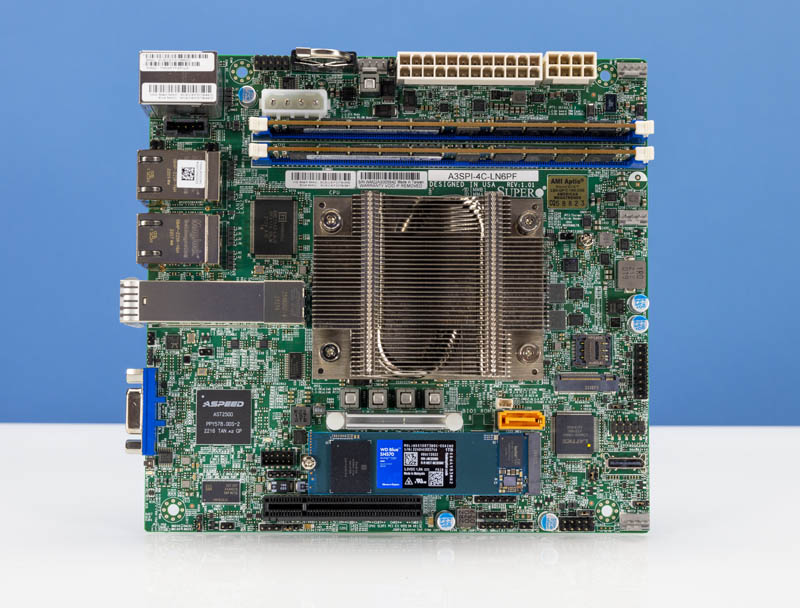
Onboard, we have the Intel Atom C5315. Supermicro uses a number of SKUs, but this is the 4-core / 4 thread unit. Intel actually sells the chip itself for $213.
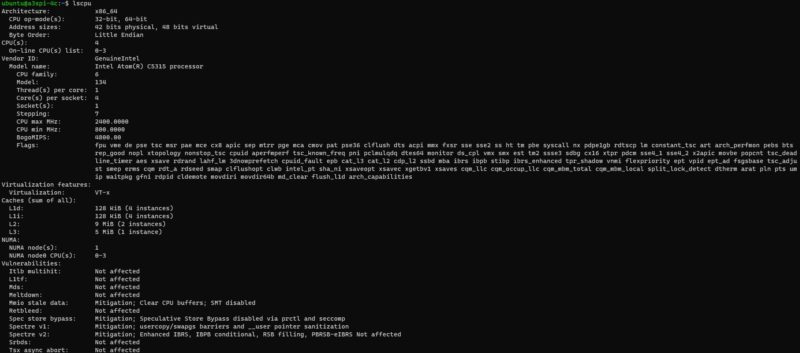
That should seem like quite a bit. The Intel Atom C3558R is the previous generation 4-core model, and that was $93. Intel has a number of new features onboard, but the new part uses the updated efficient core design and has new QAT. At the same time, it has a much higher TDP (38W v. 17W) and fewer maximum PCIe Gen3 lanes (12 v. 20.)
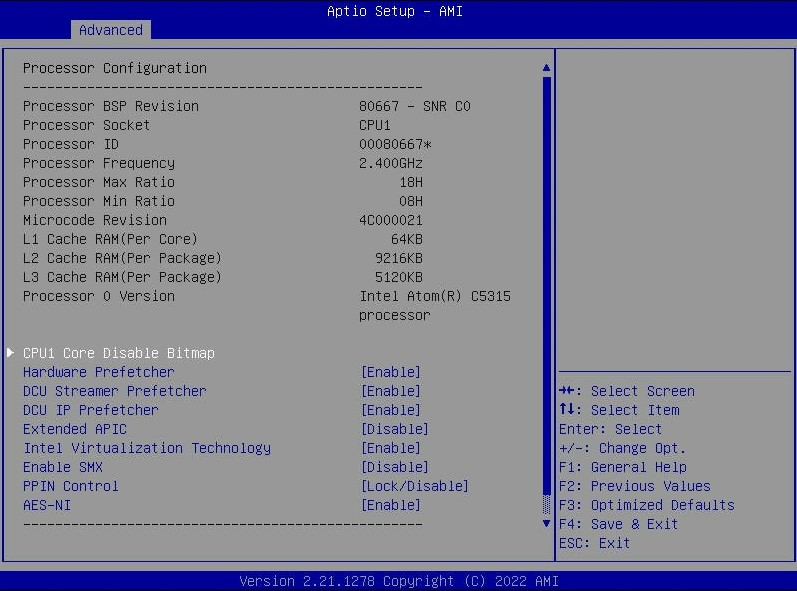
As a result, we think of the Intel Atom C5315 as a “funky” chip. It is better in some ways, but in others it does not feel like an enormous upgrade over a 2017/ 2020 (the Intel Atom C3000 line was quietly refreshed in 2020 with the C3558R.) Still, that is the chip that is on this motherboard.
Powering the unit, even though this is a mITX platform, Supermicro has both a traditional 24-pin ATX as well as an 8-pin for DC input (we used the DC input and the platform generally ran sub-40W although with higher power optics, more drives, and so forth we could push it higher.
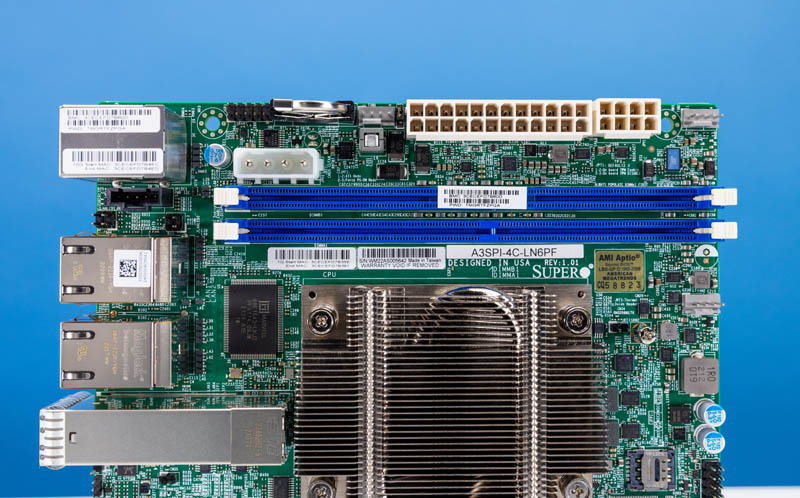
A really nice feature of this motherboard is that it is using DDR4 memory and RDIMMs. The Intel Atom C5315 has a de-rated speed of DDR4-2400 so we were able to re-use some 16GB RIMMs we had. New servers use DDR5 and can only use RDIMMs, so this is a welcome difference with the platform. If you want to learn more about memory speed scaling, we have this piece. We also have a piece on server DDR5 RDIMMs v UDIMMs and a video for that covering both.
Below the CPU and SFP cages, we get an AST2500 BMC. This is the older generation BMC as the Supermicro X12SDV-4C-SP6F we just reviewed uses the newer ASPEED AST2600.
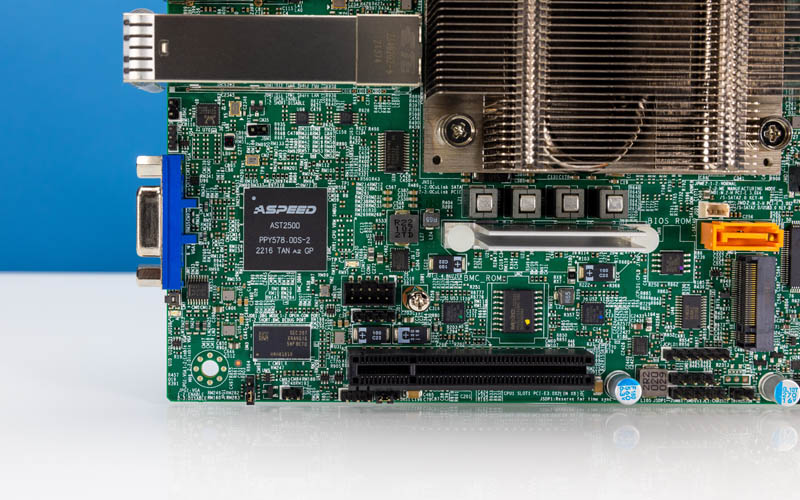
The M.2 slot is a M.2 2280 (80mm) slot that operates as PCIe Gen3 x4.
Along the bottom, the PCIe slot may look like an x8 slot, however, it is only a PCIe Gen3 x2 slot. Supermicro uses an open-ended slot, but the bandwidth is not high enough for dual port 25GbE adapters or anything like that. With this motherboard, the highest speed PCIe slot is actually the M.2 slot.
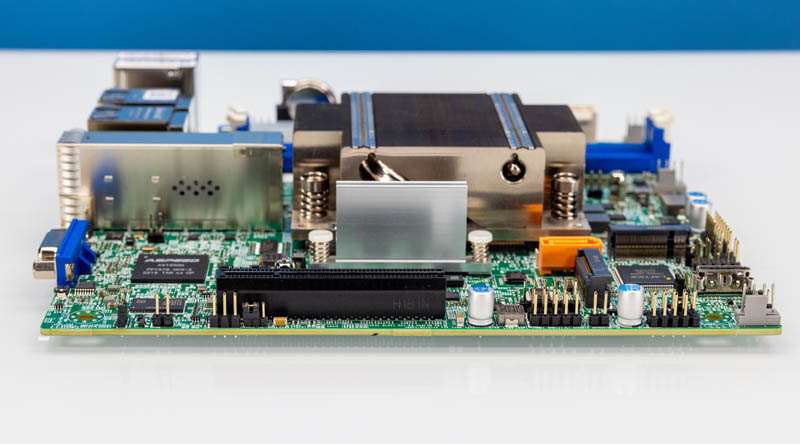
There is a second B-key M.2 that is a 3052 slot that is PCIe Gen3 x2, USB 3.0, SATA III. This is designed for adding networking. Below that, there is a nano-SIM slot that we did not get to use.
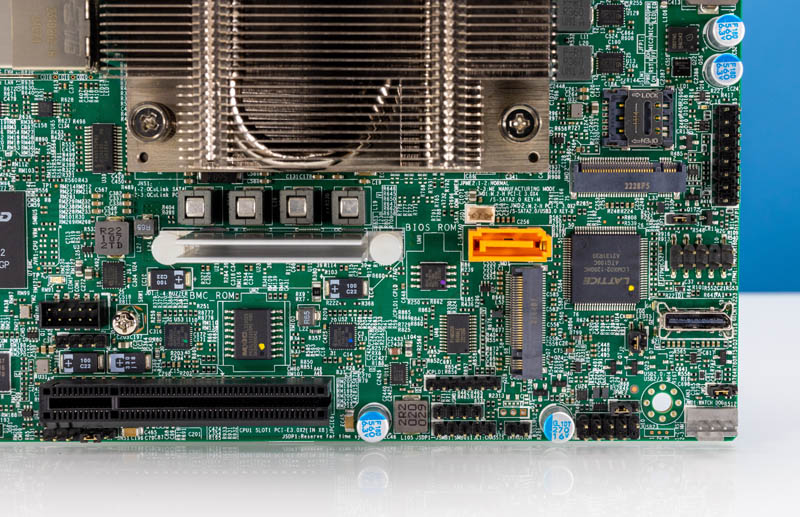
M.2 storage has really taken over here. There is a single SATA III “gold’ port that allows one to power a SATA DOM without a cable. The Oculink port is spec’d as SATA only, and the cables are relatively pricey. It almost feels like that was not a primary feature of the motherboard, so an Oculink connector was added just to save PCB space.
The primary I/O of the motherboard has Supermicro’s traditional IPMI out-of-band management port, two USB 3 ports, and a VGA port for administration.
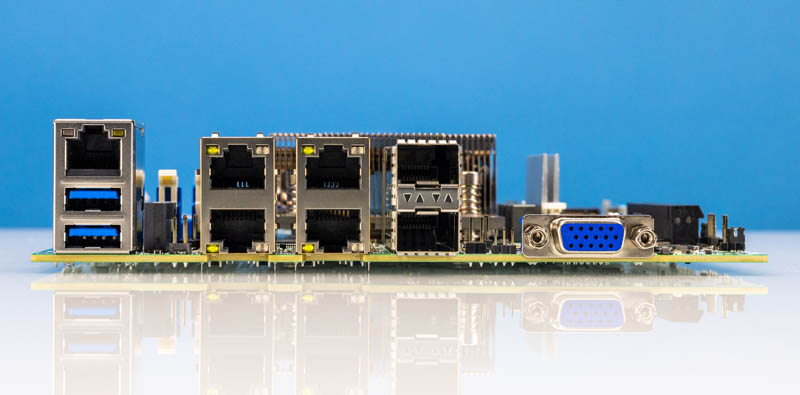
The big story though is the networking. Four ports are all 1GbE ports. These are a little different since they are not the Intel i210/i211 ports nor the i350 ports that we have been accustomed to seeing for years. Instead, they use a Marvell PHY that is transparent to the OS, but the MAC is actually the Intel E822-L built into the Atom C5315. The SFP cages are listed as SFP, not SFP+ on the spec page in three places (below the motherboard and #6 key features to the right, and not shown in the networking section below.) They are also listed as SFP in the motherboard manual.
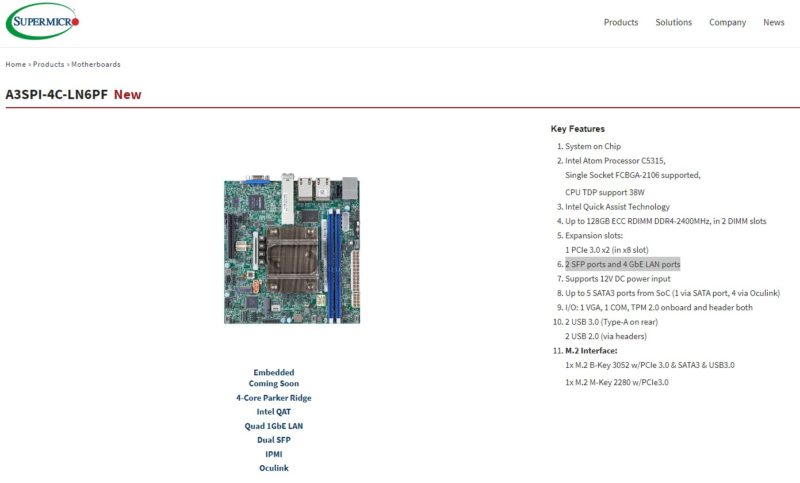
While the prospect of having only 1GbE (more on testing the speed of those SFP ports later in this article) left us nervous, the chip does support Intel QuickAssist that we have tested extensively. This is the Gen2 QAT, not the Gen3 that we get with the Snow Ridge P5300 parts.
There is a lot here, but we see this as the successor to the Intel Atom C3558 as a 4-core part in the Atom line for embedded appliances.
Next, let us get to management.

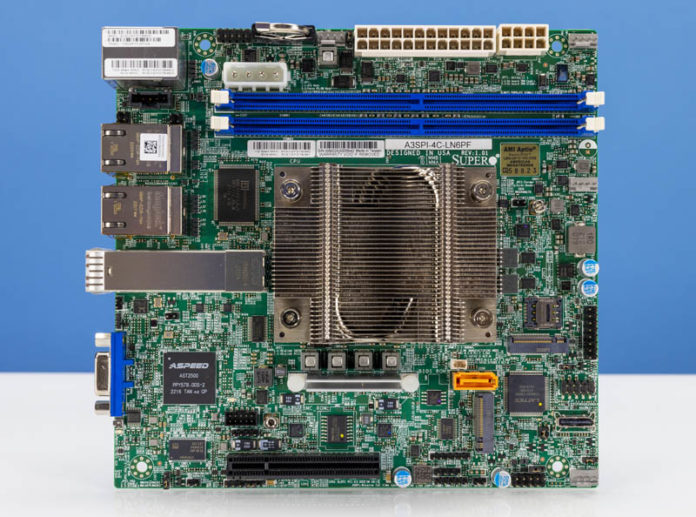
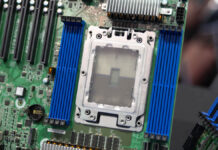
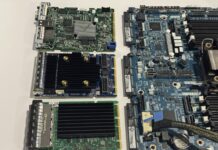
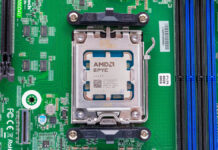
That it is still being beat by the Epyc 3101, a 4 core, cpu without smt from 2018 that has a lower power consumption is less than encouraging. Unless Supermicro puts up their first born as a guarantee of the sfp+ abilities, nothing in my past experience with that company would ever bring me to think that this was anything other than a screw up on their end that will be removed either by hardware change or bios lock/neglect.
I’ve been waiting for an updated variant of A2SDI-H-TF for 6 years now. Cheap (~500€), low power (25W), 12sata, 10gbit board and I fear this still wont be it. I won’t be cheap, nor is it low power, and with reduced lanes probably not gonna have a 12sata or its gonna be even higher priced and power hungry model.
@Dami you are essentially right.
Higher TDP, basically 1 NVMe and 1 Sata port (where are all the other lines used for storage went?), and a not-so-exiting networking part.
And benchmarks on all but SSL are basically worse than a C2758, the C2000-era flagship.
I see no real use case for a box like this.
Assuming that the SFP cages are in fact 10GbE this one looks like a competent implementation of the SoC it has to work with(though I’m a little surprised that they allocated 4x lanes to the m.2 and left the PCIe slot with only 2, given that network appliance scenarios don’t tend to lean desperately hard on local storage; and you’d need to be running a pretty decent SSD and a pretty heavy OS for 2-lane NVMe to make boot times or logging unacceptably slow); I’m just wondering what Intel thinks they are playing at.
$120 more than the prior gen part, plus substantially more power hungry; plus less PCIe; for what appear to be pretty marginal generational improvements?
I can understand the premium that network-included Atoms carry vs. the ones that show up in very low end client systems and cheap ‘n cheerful pfsense boxes; even if you don’t care about ECC you won’t actually save much if need to add anything faster than 1-2.5GbE as discrete parts; but $120 is the premium vs. the last gen version of the more or less identically placed part.
I can’t tell if Intel is surprisingly unconcerned by ARM network oriented processors; or if they are really concerned and figure that they might as well extract what they can on the way out of this niche. Over in Xeon-D land there’s still a pretty solid per-thread performance case to be made; but a 4 core fairly high TDP Atom part isn’t in Xeon-D land.
This is a surprisingly weak improvement for near 6 years.
I was looking for a reasonable amount more at the same tdp or of course, significantly more at a higher one.
I do wish AMD would compete in this space , including the platform and board variety, not just processor performance.
After the Intel Avoton fiasco, there’s no way I’m considering the stuff when there are other options.
We were looking forward to this platform but the underwhelming CPU upgrade from the C3000 series and disappointingly large price increase has us looking elsewhere.
Any throughput testing, even just a basic iperf, to see if those 10GbE rates are the real thing, and not just a configuration hiccup somewhere? The thing is certainly confused enough about itself, I wouldn’t be surprised by anything at this point.
The SoC is trimmed down Snow Ridge, which is not very fresh but still very interesting for a number of use cases. These SKUs are a bit old but good if priced correctly (room for 2/3 NVMe SSDs, up to 12 SATA ports, QAT, 10Gbit networking), what really sucks here is Supermicro: they have never managed to get the Atom line right, with the correct offering and ports. Can you explain to me why you must loose 2 PCIe lanes for a B-key M.2 slot on a system with 20Gbit ethernet? WHY? Why a 2 lanes PCIe expansion slot? This way they are both useless! Do you want a small scale NVMe NAS? You can’t now with a C5315. Do you want more than 5 Sata ports? You can’t although the SoC supports them! It’s nonsense, why is Supermicro run by this guys? They try to satisfy multiple scenarios with one product failing badly for all of them.
@Safari
“Can you explain to me why you must loose 2 PCIe lanes for a B-key M.2 slot on a system with 20Gbit ethernet?”
This was actually the reason I bought this board (A3SPI-8C-LN6PF), because you can use it for a 5G cellular modem as a backup link (hence the SIM card slot).
At least that was my intention. Apparently there is a bug in the firmware that does not detect a PCIe cellular modem in the M.2 slot. This issue has been open for 2 months and has been escalated to Intel with no fix or workaround available yet.
@elk Because buying this board/SoC for such a purpose makes no sense. It does makes sense to use it for storage, but you must not waste the few precious PCIe lanes with nonsense slots.